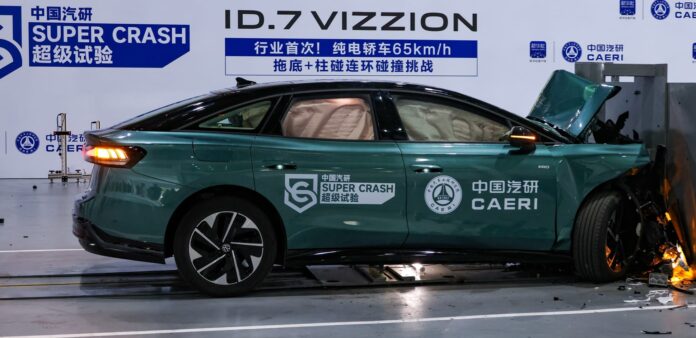Volkswagen sold 9 units of its all-electric sedan ID.7 in China last month, down 99.6% from 2,269 units in January 2024. The German automaker sold only 4,552 electric vehicles (EVs), down 71% from 15,828 in January 2024.
Its best-selling car was the ID.3 hatchback, which sold 2,623 units, down 65.5% from the same month last year. It was followed by ID.4 X, which sold 1,020 units, down 70% from last year, and ID.4 Crozz, which sold 889, down 59.3% from last year.

Volkswagen manufactures the ID. series of electric cars, with its two main joint ventures being SAIC and FAW. For example, ID.4 X and ID.4 Crozz are nearly the same car but made with different Chinese partners.

The ID.7 Vizzion, which sold nine units in China in January, is made with FAW. Last year, the SAIC joint venture unveiled ID.7 S, a slightly bigger version of ID.7, but sales never really took off, foreseeing the future of ID.7 Vizzion.
VW ID.7 Vizzion started pre-sales in China in November 2023 and launched a month later, in December, for 227,777 yuan (31,400 USD) for an RWD version with a 642 km CLTC range, 84.8 kWh battery pack, and single 150 kW e-motor.

After rounds of discounts, the ID.7 RWD now starts at 197,700 yuan (27,200 USD), and the AWD version with 230 kW and 472 Nm peak torque starts at 232,700 yuan (32,000 USD).
Editor’s comment
Volkswagen ID.7 Vizzion is a Tesla Model 3 competitor that had to compete in China’s most deadly market: the overcrowded 200,000 yuan (27,300 USD) sedan segment. The ID.7 had to rival not just Model 3 but also a flood of new electric sedans from Chinese EV startups and legacy automakers such as BYD Seal, Xpeng P7i, Nio ET5, Xiaomi SU7, Zeekr 007, IM L6, and dozens of others. Moreover, SUVs are much more popular in China than sedans, and they are outselling them at 1:3.


However, the Wolfsburg-based legacy maker had a chance – the Chinese love Volkswagen. Especially for older buyers, it is a synonym for German quality. Younger buyers tend more to the new local EV startups, but even they know that Das Auto can make a good car.
And that’s the problem. They know how to make a good car but don’t know how to make good EVs for China. From talking with dozens of EV buyers, I can tell that young buyers no longer care about steering feel, chassis, driving dynamics, build quality, and other stuff at which Volkswagen is best. They want connectivity, OTA updates, watching a movie in the car (many adult people in China live with their parents, and this is using the car as a “second living room”), connection with smartphones and home appliances, narrow bezels on screens, no lagging, perfect UX and fair enough ADAS. And Volkswagen didn’t offer any of this on ID.7 and ID. series in general.
However, I remain pretty optimistic about Volkswagen’s future in China. The company signaled they were not ready to leave the largest automaker in the world. It doubled down on China, announcing heavy investment, and an “In China, for China” strategy that fastened the product development cycle by partnering with or acquiring local startups and automakers. We will know more when the first Volkswagen EVs based on the Xpeng platform or Audi’s based on SAIC’s IM platform will launch. We will keep an eye on that.


